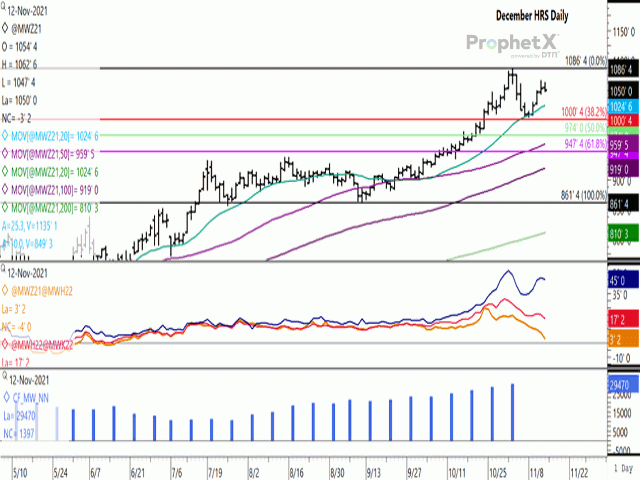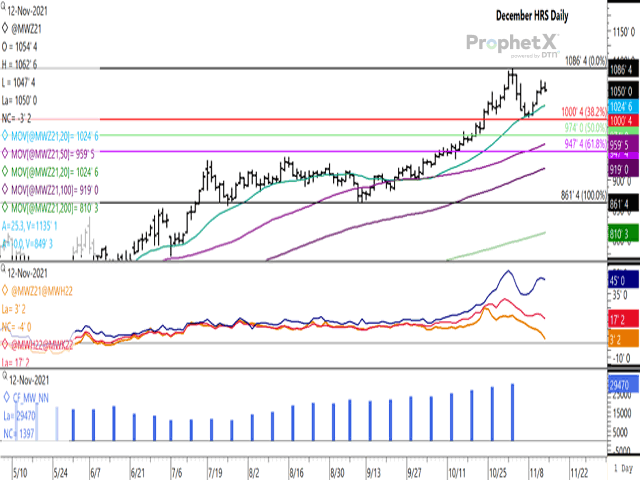Canada Markets
Spring Wheat Market Signals Bears Watching
Nov. 12 trade proved lacklustre for hard red spring wheat, with the December contract ending down 3 1/4 cents, while soft red winter wheat closed 4 1/2 cents higher and hard red winter closed 5 cents higher, with both winter wheat contracts reaching fresh contract highs. As seen on the attached chart, the spring wheat contract has lost traction on its move back towards a contract high, with today's trade consolidating within the previous session's range in a sideways move.
Weekly charts show spring wheat for December delivery closing 40 1/2 cents higher, while SRW ended 50 1/2 cents higher and HRW settling 54 1/4 cents. Again, the difference between winter wheat and spring wheat trade is that HRW reached three consecutive contract highs, SRW reached contract highs in each of the past two sessions, while spring wheat's high was 20 1/2 cents below last week's contract high.
This week's USDA World Agricultural Supply and Demand Estimates (WASDE) report remained bullish for hard red spring wheat. Total supplies of HRS are estimated at 587 million bushels, or 15.975 million metric tons, down 31.6% from last crop year and the lowest reported in USDA data going back to 1984-85. Ending stocks are reported at 127 mb or 3.456 mmt, the lowest seen since 2007-08. The stock/use ratio is calculated at 27.7%, down from 37.7% in the previous crop year and from 50.4% just two years ago. This is also the smallest ratio calculated since 2007-08.
P[L1] D[0x0] M[300x250] OOP[F] ADUNIT[] T[]
At the same time, this report proved less bullish than the October report. The USDA's export forecast was revised lower this month while ending stocks were revised higher.
Another indication of a less bullish situation is seen in the HRS/HRW futures spread (not shown), which is viewed as a proxy for the demand for high protein spring wheat. The December contract spread has weakened for a second week to $2.17/bushel (bu), down from a recent high of $2.66 1/2/bu. The spread between DTN's cash market indices have also weakened for a second week to $2.05/bu, down from a recent high of $2.495/bu and the weakest spread seen in six weeks.
As seen on the first study of the attached chart, the December/March HRS futures spread weakened to 3 1/2 cents, a third consecutive week of weakness to a modest inverse (December over the March), a level last seen on June 23 of this year. This spread has corrected from a high of 24 1/2 cents reached as recent as Oct. 22.
The lower study shows a record noncommercial net-long futures position held as of Nov. 2, which could prove a bearish feature should a widespread change in sentiment take place and the speculative trade takes profits. Statistics as of Nov. 9 will be released on Nov. 15 due to this week's Veteran's Day holiday.
Despite the overall bullish nature of this market, short-term signals should be a concern for those holding unpriced crop and some sales should be considered.
Cliff Jamieson can be reached at cliff.jamieson@dtn.com
Follow him on Twitter @Cliff Jamieson
(c) Copyright 2021 DTN, LLC. All rights reserved.






Comments
To comment, please Log In or Join our Community .